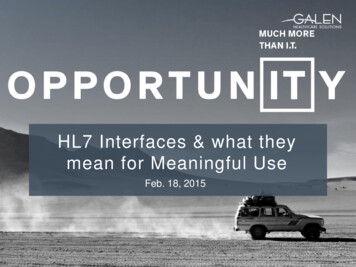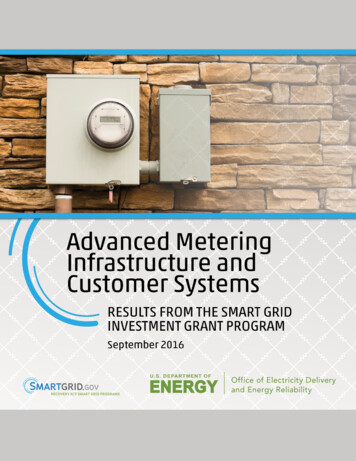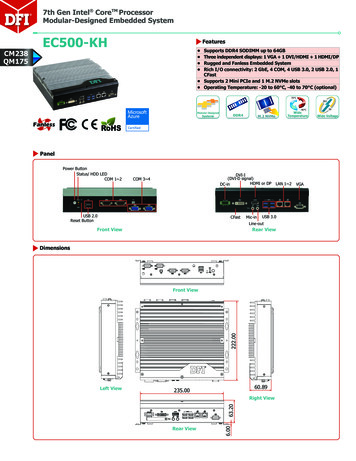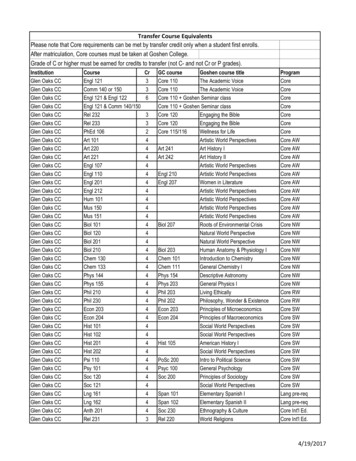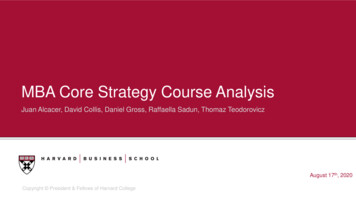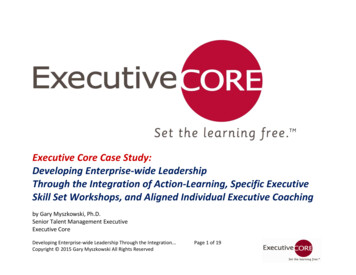
Transcription
Executive Core Case Study:Developing Enterprise-wide LeadershipThrough the Integration of Action-Learning, Specific ExecutiveSkill Set Workshops, and Aligned Individual Executive Coachingby Gary Myszkowski, Ph.D.Senior Talent Management ExecutiveExecutive CoreDeveloping Enterprise-wide Leadership Through the Integration.Copyright 2015 Gary Myszkowski All Rights ReservedPage 1 of 19
Executive Summary:The case is actually the synthesis of at least four client programs that share the common of goal of developingthe next generation of senior executives with enterprise-wide strategic leadership capabilities. The case studyhighlights the programs' similar approaches to integrating action-learning processes, the delivery of specificexecutive skill set workshops, and individual executive coaching while aligning each individual's developmentneeds with the common target enterprise-wide leadership competency model. As assessed by the clientprogram sponsors, the leveraging of a multipronged approach accelerated the development of a cadre of highpotential executives and increased their readiness to advance to key roles requiring enterprise-widecompetencies. In some cases, the clients sponsored similar programs for three or more successive waves ofexecutive participants over the following four to five years.DisclaimerThis case study is the disguised synthesis of four similar enterprise-wide leadership programs that members of Executive Core haveco-designed and / or co-delivered for over the past ten years. These clients were all Fortune 500 businesses. All but one of theseclients consider the specifics of their respective programs to be a source of competitive advantage for the purposes of seniorexecutive talent development and improved business results. One program was more publicly visible as a result of receiving anaward for excellence in executive development. No identifying information of the companies, individual participants, or companyspecific program design elements is described here. Instead, the essential common elements of the programs and the advantages ofusing a multipronged development approach are identified and described. Any similarity with an existing or recent program iscoincidental and reflective of the growing acceptance and use of custom in-house intensive leadership development programs usingthese methods.Developing Enterprise-wide Leadership Through the Integration.Copyright 2015 Gary Myszkowski All Rights ReservedPage 2 of 19
Context: The Need for ACME to Aggressively Develop Executives with an Enterprise-Wide PerspectiveACME Corporation1 is a global company that was formed as a US-based manufacturing2 company shortly after WW II. Over theyears, ACME slowly evolved into a multi-national company, expanding first into North America and Europe. It dabbled selectively inSouth American manufacturing and distribution locations, but was reluctant to invest more in that region due to continuinggeopolitical unrest, disruptions, and uncertainty. In contrast with its historical strategic intent of being a "fast follower," the currentgeneration of top executives desire a more aggressive entry into China and other Asian countries, where there is a growingsignificant middle class who are potential customers of ACME's products. Through the years, the company has maintained itsheadquarters in the US Midwest, populated largely by US-born executives and managers.The strategic decision to more aggressively enter Asian markets is critical to achieving ACME's future growth aspirations. The nextgeneration of ACME leaders will need intimate knowledge of how to conduct business in Asia, an ability to recognize subtle changesand trends in current ACME national and regional markets, and a surveillance of emerging markets where ACME might want to riskbeing a first mover with a committed entry.Historically, ACME selected and developed a cadre of executives with multinational experience. This multinational executive talentpool was developed largely through rotational assignments across several countries and the informal coaching they may or may nothave received from their predecessors, peers, and senior executives. Using these methods, it often took 15 to 20 years for ACME todevelop a senior multinational executive, such as a country manager. In addition, only the few very senior executives at the top ofhouse possessed an enterprise-wide perspective of the business, ACME's strategies for its portfolio of businesses and locations, andthe business, political, and economic trends that would cause the company to adjust or change those strategies. To pursue itsgrowth aspirations, ACME now needed to grow a cadre of executives with an enterprise-wide strategic perspective quickly.Footnote 1: This company is often confused with the ACME company that was the preferred supplier of Wile E. Coyote of Warner Bros. Looney Tunesand Merrie Melodies cartoon fame. In contrast, the ACME referred to in this article assures us, for example, that its "Rocket Powered Roller Skates"are much more manageable, stable, and reliable than those depicted by the fictional cartoon company.Footnote 2: We consciously did not identify the range of products produced by ACME because we want to focus the case study readers' attentions onthe learning program and not on ACME's marketing, manufacturing, or supply chain practices.Developing Enterprise-wide Leadership Through the Integration.Copyright 2015 Gary Myszkowski All Rights ReservedPage 3 of 19
The Alternatives for Enterprise-wide Leadership DevelopmentIn the past, ACME had selectively sent some of its "high potential" executives to university-based Executive MBA programs and a fewfree-standing Global Executive MBA programs. To be considered as part of the multinational executive pool, "high potential"executives were developed through rotational assignments across national and regional boundaries and expat assignments.Individual executive coaching provided by external professionals was offered either in response to the request of an individual "highpotential" executive or as a remedial intervention when a valued executive was underperforming or potentially derailing. Executivecoaching was not systematically used for development of "high potential" executives.The Limitations of MBA ProgramsWhile the external EMBA programs were an excellent introduction to an array of business tools and conceptual frameworks thatwere designed to build the foundation for an enterprise-wide view, ACME participants studied many facets of multinational or globalbusiness that did not, and probably would not, directly relate to the specific challenges facing ACME. In a sense, for the time andmoney spent, they were often a little too generic, trying to reach students from an array of businesses and industries.The Challenges with Delivering In-house Custom Executive Development ProgramsCustomized in-house executive education programs provided an opportunity to align the learning opportunity with the specific andsometimes unique challenges facing the ACME businesses. The biggest hurdle to successfully designing and implementing theseprograms was not the willing availability of ACME senior executives to actively participate in the "teaching" (they readily madethemselves available), but it was finding the very few university-based academic subject matter experts who would actually tailortheir presentations to the specifications of ACME. Instead, ACME Chief Learning Officers often experienced the university facultymember delivering the exact same lecture or presentation he or she gave two weeks prior in the university-based day MBA programor the EMBA program. Co-designing was apparently not a developed competency among university faculty members. A seconddeficit was the apparent trend of the faculty to overestimate their abilities to facilitate the discussions of intact business teams.Instead, they tended to dominate those discussions instead of create space for those teams to learn how to have constructive andoften contentious discussions without the frequent facilitation (or interruption) from an external facilitator.Developing Enterprise-wide Leadership Through the Integration.Copyright 2015 Gary Myszkowski All Rights ReservedPage 4 of 19
The Incomplete Leveraging of Expat Rotational AssignmentsHigh potential rotational assignments were considered to be extremely valuable but not very consistent or efficient. The opportunityto glean the insights and wisdom from ACME executives and "others who had gone before" was highly dependent on the willingnessand abilities of the hosting or sponsoring executives at the rotational location to coach and mentor the executive in the rotationalassignment. Also, the learning outcomes of those assignments were never specifically identified, communicated, or evaluated.Executives were given a rotational assignment and it was hoped they would "learn something." The approach to developing theseexecutives was often haphazard and the developmental outcomes were uneven at best.Executive Coaching Used for One-off ApplicationsPutting aside the use of professional executive coaching for remedial purposes, most of the "high potential" executive coachingfocused on the coachee mastering his or her role as quickly as possible and stretching to new experiences that would pull for thecompetencies and perspective that the coachee would most likely need in the next most probable advancement opportunities he orshe was being considered for. The developmental objectives were typically not targeted at a set of enterprise-wide leadershipcompetencies.The Opportunity for SynergySo, if the alternative approaches to developing the next generation of enterprise-wide executives was rather fragmented, onlypartially targeted at the challenges of ACME, and not focused on developing a specific set of executive competencies, what wouldhappen if the approaches were modified, integrated, and aligned? Would there be some synergy of the most effective aspects ofeach to create an intense and highly effectively learning process? And could the program and learning process be co-created and codelivered through collaboration of internal subject matter experts, thought leaders, and decision makers with external subjectmatter experts on executive learning? Through co-creation and co-delivery, the program would come to be owned by the ACMEsponsors, leaders, and participants in the program, versus being an externally-generated program owned by some vendor. Thatintegration would eventually be co-designed and co-delivered as the ACME OWL program.Developing Enterprise-wide Leadership Through the Integration.Copyright 2015 Gary Myszkowski All Rights ReservedPage 5 of 19
The Fundamental Design of the ACME OWL (Organization-wide Leadership) ProgramAfter a number of consultative discussions and iterative attempts at identifying the desired goals and outcome of the OWL program,the ACME exploratory team confirmed the following with ACME senior management:"OWL is a six-month intensive learning experience, aimed at preparing executives at the Vice President level and above for thecurrent and future business challenges ACME faces in an ever-increasing complex global marketplace."The learning challenge: OWL3 is expected to shape the next generation of ACME executives who must be able to competecollectively, operate independently, and manage collaboratively.Desired Outcomes for Program: Initial proficiency to formulate and implement an enterprise-wide strategy. Growing proficiency to diagnose and proactively shape the world-wide operating environment in terms of regulatory,economic, and social dynamics. Address talent capability as a core part of ACME's business strategy and foster employee engagement. Understand and exhibit executive presence at the senior-most levels. Plan, organize and execute projects across ACME's divisions and matrix organizations. Understand and transcend personal boundaries.Note 3: The OWL program was originally named the "Breakthrough Organization-Wide Executive Leadership" program but someone representing Marketing onthe co-design team successfully nixed that idea before it developed any momentum.Developing Enterprise-wide Leadership Through the Integration.Copyright 2015 Gary Myszkowski All Rights ReservedPage 6 of 19
Overview of the Multipronged Learning Approach of the ACME OWL ProgramDeveloping Enterprise-wide Leadership Through the Integration.Copyright 2015 Gary Myszkowski All Rights ReservedPage 7 of 19
The OWL Group Learning Components Integrated with the Strategic Business Challenge (Action Learning)The Group Learning Modules were a common learning experience for all of the participants. Each module was a mixture of didacticpresentations or workshops offered by external subject matter experts, or, presentations, discussions and Q&A with internal seniorexecutives or internal subject matter experts.Module 1: Understanding the assumptions and key elements of the business portfolio strategies.This presentation and discussion with senior executives and internal subject matterexperts allowed the participants to comprehend the thinking, assumptions, andchoices behind the current business strategies and the competitive or environmentalfactors that would cause ACME to reconsider, adjust, or abandon its strategies. One ofthe learning goals for this module is the appreciation for a need to deal withuncertainty and incomplete information, while ensuring that AMCE is also externallyfocused and not just focused on current internal operations.Module 1 was conducted at ACME's corporate headquarters in Chicago to symbolizethe importance and implications of being selected as a participant for this program.Strategic Business Challenge Kick Off as Part of Module 1The senior executive sponsor for the Strategic Business Challenge gave the participant group the assignment of formulating a moreaggressive and effective country-entry strategy into China and a few select other regional countries. An external facilitator fromExecutive Core would guide the group through its research, analysis, diagnosis, planning and presentation of a proposed solution.The intended goals, business challenge process, deliverables, and timelines were described over the course of four hours.Developing Enterprise-wide Leadership Through the Integration.Copyright 2015 Gary Myszkowski All Rights ReservedPage 8 of 19
Strategic Business Challenge: Research Trip to Reynosa, Tamaulipa, Mexico (before Module 2)The primary objectives of this research trip was to learn from the successes, lessonslearned, and shortcomings of ACME's continued efforts to more aggressively enterMexico and South American. The group met with the top management of this facilitywith the intent to talk candidly about the continuing challenges facing ACME and whatit learned from its past experience. This experience would provide a real introduction toACME's country entry capabilities as preparation for Module 2. Virtual meetings werealso conducted among the Strategic Business Challenge sub-teams to begin to identifyand contact other ACME internal sources of insight and experience before the Chinatrip (Module 2).Module 2: Understanding a region / country entry strategy and the requirements of a global perspective.While in China, the group had an opportunity to meet with several externalconsultants about the best practice processes for entry into China and the culturaland social mores that created Chinese expectations for acceptable business practicesand behaviors. The first module described the challenges in dealing effectively withmultiple Chinese Ministries. The research component included consultations withseveral Chinese national representatives who received their MBAs in the US and nowrepresented US companies to Chinese partners, alliances, and a few mainland Chinacompanies. A site visit to a local manufacturer who produced products similar toACME's and represented a possible future contract manufacturer completed theresearch component. Module 2 finished with a review of other possible priorityAsian countries for entry beyond China with an external consultant. Virtual meetingswere conducted to consolidate and verify the Strategic Business Challenge teams'learning from Module 2.Developing Enterprise-wide Leadership Through the Integration.Copyright 2015 Gary Myszkowski All Rights ReservedPage 9 of 19
Module 3: Developing a Talent Pool / Leading Organizational ChangeBeyond North America, Europe was ACME's second major regional market ofexpansion. It was AMCE's first experience with populating key regional positions withnon-US, European nationals and learning to trust them to run the business in the bestinterest of ACME and not the primary interest of the local national employees orgovernments. One major component of the didactic learning in workshops withexternal consultants included experience with models to lead large scaleorganizational change over time against the constraints of specific Europeangovernments. The second major component identified the best practices for seniorexecutives to create and manage a pool of executive talent below them. This wascomplemented by a workshop in how each executive could effectively coach his or herdirect reports. Research was also conducted with the top executives at ACME Krakowtechnology center on how to manage intellectual property across national boundaries.Virtual meetings were implemented among the Strategic Business Challenge Team sub-teams to begin to formulate a long rangecountry entry strategy into China.Module 4: Executive Presence and InfluenceEach of the Canadian provinces offered different regulatory and political challengesthat ACME has had to address over the past forty years. While visiting the ACMECanadian headquarters and technology center the group also attended workshops onexecutive presence and influence. Participants began to plan influence strategies forboth creating receptivity within ACME for the proposed solution to the StrategicBusiness Challenge but also to key decision makers and influencers in China assumingthe proposal would be accepted by ACME senior management. Virtual team meetingsoccurred among all of the team members and sub-team members to finalize theproposed solution into a sequence of presentations given by specific participants ofthe OWL program.Developing Enterprise-wide Leadership Through the Integration.Copyright 2015 Gary Myszkowski All Rights ReservedPage 10 of 19
Module 5: Finalizing the proposed action plan and presenting to senior management.Day 1 was primarily invested in timed rehearsals of the sequences of presentations,feedback for refinement of delivery, modifications and simplification of thesupporting slides, and preparation for anticipated questions and the most effectiveanswers.Day 2 included the presentation to senior management, feedback and an initialresponse to the proposed business solutions, and a celebration of the learningprogram regardless of the degree to which the recommendations were immediatelyaccepted.Developing Enterprise-wide Leadership Through the Integration.Copyright 2015 Gary Myszkowski All Rights ReservedPage 11 of 19
The Ongoing Aligned Individualized Development and Coaching ProcessesThe individualized development program was designed to specify the target set of competencies that all participants would probablybe attempting to develop and demonstrate throughout their remaining careers with ACME. It was not assumed that everyone wouldbe flush with the competencies by the time the six month program was completed.A shown below, the co-creation of these target competencies required the facilitation of an internal expert panel of experiencedACME executives supplemented and informed by external Executive Core consultants and other available subject matter experts. Asa target or standard for development, the Organization-Wide Leadership (OWL) competency model needed to be accurate, valid,and owned by the executives who would use the model for their own development, the development of their direct reports, and forselection and advancement decisions.Once the OWL competency model was defined with behavioral indicators, ACME OWL participants selected their 360 feedbackrespondents pending review and refinement by ACME HR and senior management. Given the fewest competencies that would makethe greatest difference in performance, the sponsors also wanted to ensure that the participants received balanced feedback fromthose who had an opportunity to observe the participants' recent typical behaviors and performances in successful endeavors and invery challenging circumstances.Concurrently, each of the external Executive Core senior executive coaches selected by each participant (some coaches wereselected by more than one participant) were oriented to the content and intended learning outcomes of each of the group learningmodules as well as the Strategic Business Challenge, so the coach could integrate them into the individual coaching sessions.For the first OWL program, there would 20 participants.Developing Enterprise-wide Leadership Through the Integration.Copyright 2015 Gary Myszkowski All Rights ReservedPage 12 of 19
The 360 feedback process was implemented and the results of each respondent were consolidated either in a survey aggregatereport or by synthesis of the respondent interviews by the respective Executive Core senior executive coach. The report wasreviewed by the coach and provided to the OWL participant just prior to Coaching Session 2.Developing Enterprise-wide Leadership Through the Integration.Copyright 2015 Gary Myszkowski All Rights ReservedPage 13 of 19
Coaching Session 1 allowed the Executive Core senior executive coach to orient the OWL participant to the intended process andoutcomes of the entire OWL program and answer any emerging questions before engaging in the first steps of the program. Theexecutive coach also obtained a psychosocial history from the respondent with the intent to identify characteristic patterns ofbehaviors that were either consistent with and supportive of the competency model or potential strong preferences or personalitycharacteristics that would need to be consciously managed in order to improve the executive's performance in a role focused onenterprise-wide leadership and influence. By focusing on the OWL participant's self-assessment and inviting the executive to bemore self-disclosing about the high and low points of his or her personal and professional history, the coach develops a beginningsense of trust and rapport in the coaching relationship.Coaching Session 2 was an opportunity for the OWL participant to compare his or her own self assessment vis-à-vis the ACMEEnterprise-wide Leadership competency model and the 360 feedback from others. This allows the coach and participant to confirmstrengths, development needs, potential blind spots, and possible strong preferences or personality characteristics that will requireconscious management in order to improve leadership effectiveness.After the Coaching Session 2, the executive coach created an individual development plan (IDP) for the OWL participants. This planwas considered "a living document" that would be refined as the executive had new experiences either in the OWL Modules or inthe Strategic Business Challenge. The IDP served as a baseline and guide for the coaching discussions to ensure that the intendedprogram learning and the initial developmental needs of the participating executive were being integrated into attempts at new andmore effective behaviors for the executive.Each following coaching session inquired about the OWL participant's learning from the most recent Module or Research Trip andcompared that to the intended learning outcomes. Blind spots or omissions were identified and the intended learning outcomeswere reinforced.The Executive Core facilitator of the Strategic Business Challenge and others provided feedback in Module 5 on the content andprocess of each of the presenters in rehearsal, bringing the detailed tactics and behavioral indicators of executive presence to life.Coaching Session 8 is designed to both provide a self (or other, mini-360 ) evaluation of progress, refinement of the point-forwardindividual development plan, and closure to the coaching relationship.Developing Enterprise-wide Leadership Through the Integration.Copyright 2015 Gary Myszkowski All Rights ReservedPage 14 of 19
Developing Enterprise-wide Leadership Through the Integration.Copyright 2015 Gary Myszkowski All Rights ReservedPage 15 of 19
ConclusionIn Module 5, several career changing events occurred: Executives who were more introverted and previously invoked reading off of slides and "death by PowerPoint" culled theirpresentation deck to just a few key slides and instead spoke slowly and calmly from the heart. Participants provided useful preliminary information in private conversations with sponsor and "audience" top executivesprior to the presentation to discuss the key proposal points and obtain their understanding and feedback prior to the finalproposal presentation. They used an influence strategy to reduce the dynamic of the meeting as a "make or break"presentation. One foreign national executive who tended to talk quickly with a thick accent slowed his speech down and annunciated hiswords for his entire presentation and question and answer period. A few participant executives who, in the past, tended to take on the role as "the best and the brightest in the room,"appropriately redirected questions from the top executives to other key team members who possessed more expertise onthe topic in question. Participant presenters were not afraid to respectfully, but confidently, push back on top executive challenges to theproposal's definition of the presenting organizational capability gaps to enter China and the organizational changes thatwould be necessary in order to close those gaps.Outcome of the OWL program: The essential assessment of the current organizational capability gaps and the changes necessary to close those gaps wereaccepted, pending the involvement and refinement of other key stakeholders, under the sponsor's oversight. The sequence and timing of the changes were the biggest differences between the actions proposed and the actual actionsimplemented. Otherwise, the essence of the proposal remained intact.Developing Enterprise-wide Leadership Through the Integration.Copyright 2015 Gary Myszkowski All Rights ReservedPage 16 of 19
A number of the participants were asked to take on additional roles to participate in the leadership of the development ofthe new capabilities. Several participants were promoted within the next 18 months to take on significantly broader enterprise-wideaccountabilities. Even during the course of the program, learning had generalized back to their current roles.Top management considered the ROI of the program to valuable enough to warrant the exploration of:1. The identification of the next cadre of executives to go through a similar program with a different strategic businesschallenge; or2. For "high potential" executives deeper in the organization, how to begin to develop real enterprise-wide competencieswithout engaging in the full comprehensive OWL program.For the reader:1. What is the current need to develop executives with a strong and accurate enterprise-wide understanding, competencies,and credibility in your talent pool?2. What specific programs or learning interventions are you currently engaged in to develop more executives with thesecompetencies? Are they providing you with the desired talent pool and likely successors?3. Would you consider having an initial no-obligation exploratory discussion with a senior Executive Core executivedevelopment consultant to identify your most likely next steps (without having to immediately reach for a world-classprogram)?See: www.executive-core.com and find your local regional Executive Core representative.Search "Introduction to Executive Core Executive Education" on YouTube.Developing Enterprise-wide Leadership Through the Integration.Copyright 2015 Gary Myszkowski All Rights ReservedPage 17 of 19
####About the author:Dr. Gary Myszkowski has helped senior executives manage rapid change for almost 30 years. Hecurrently serves as an executive coach to high potential executives about to become Vice Presidents,C-Suite executives, and their teams. He specializes in facilitating the transitions of senior executivesinto new roles, for both external hires and internally promoted incumbents.Gary also specializes in large group interactive meeting design and facilitation to accelerateorganizational change, design and facilitation of business team strategic planning, and shapingorganization capabilities for strategy implementation.In related roles, Gary also serves as faculty and facilitator for customized senior executivedevelopment programs and as adjunct faculty for several Executive MBA programs in the US.Gary has extensive experience both as an external coach and consultant as well as a director-level executive leading an internalconsulting group. He was the co-leader of Amoco’s global integrated Learning and Organization Effectiveness shared services groupand the strategic partner to two presidents of Amoco Chemicals and their executive teams.Gary has served as a change management consultant to mergers and acquisitions ranging from 50 million to 35 billion. He hasbeen on “both sides of the desk” as a member of due diligence, integration and change management teams—as the acquiringcompany and a company being acquired.Prior to Amoco, Gary also served as a Regional Practice Director for Talent Management for a premier global human resources firm,based in their Chicago of
The Alternatives for Enterprise-wide Leadership Development In the past, ACME had selectively sent some of its "high potential" executives to university-based Executive MBA programs and a few free-standing Global Executive MBA programs. To be considered as part of the multinational executive pool, "high potential"




